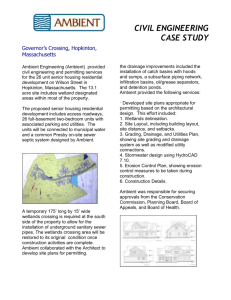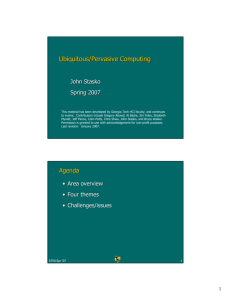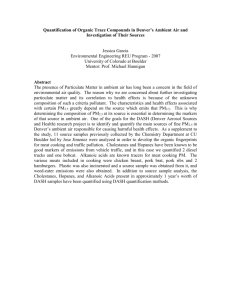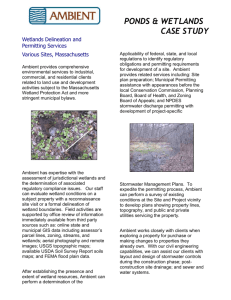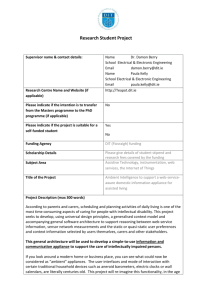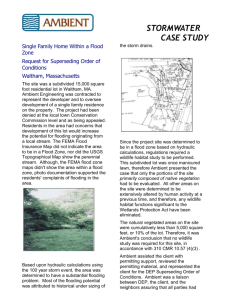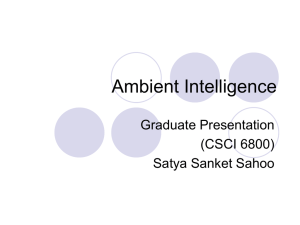ambientROOM: Integrating Ambient Media with
advertisement
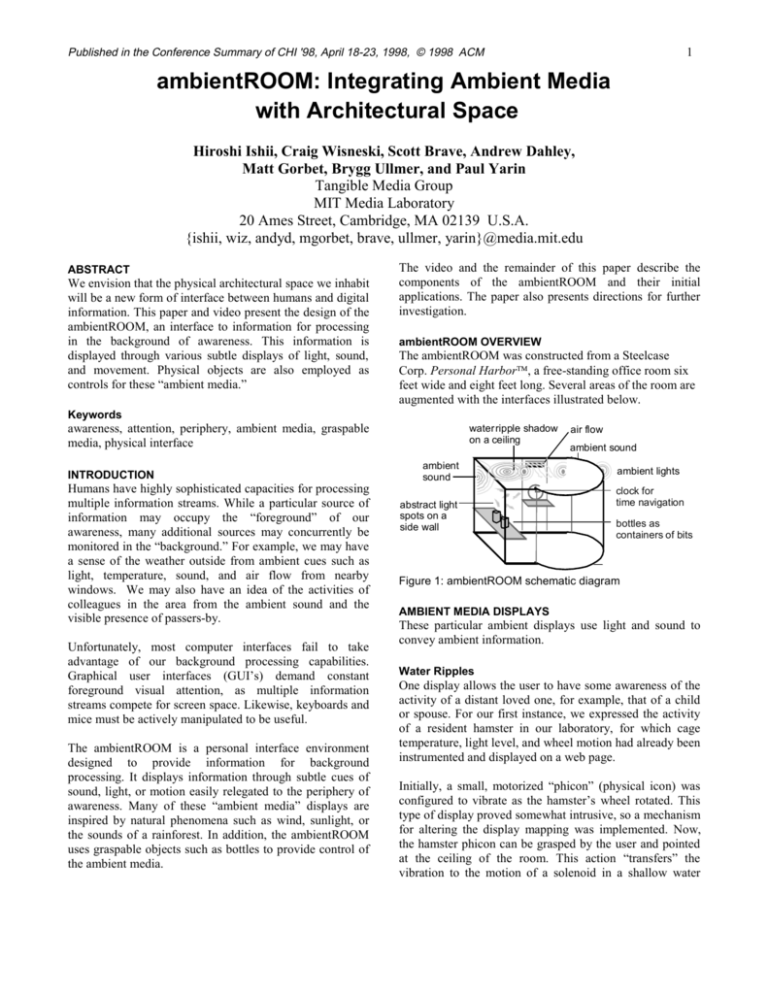
1
Published in the Conference Summary of CHI '98, April 18-23, 1998, © 1998 ACM
ambientROOM: Integrating Ambient Media
with Architectural Space
Hiroshi Ishii, Craig Wisneski, Scott Brave, Andrew Dahley,
Matt Gorbet, Brygg Ullmer, and Paul Yarin
Tangible Media Group
MIT Media Laboratory
20 Ames Street, Cambridge, MA 02139 U.S.A.
{ishii, wiz, andyd, mgorbet, brave, ullmer, yarin}@media.mit.edu
ABSTRACT
We envision that the physical architectural space we inhabit
will be a new form of interface between humans and digital
information. This paper and video present the design of the
ambientROOM, an interface to information for processing
in the background of awareness. This information is
displayed through various subtle displays of light, sound,
and movement. Physical objects are also employed as
controls for these “ambient media.”
The video and the remainder of this paper describe the
components of the ambientROOM and their initial
applications. The paper also presents directions for further
investigation.
ambientROOM OVERVIEW
The ambientROOM was constructed from a Steelcase
Corp. Personal Harbor, a free-standing office room six
feet wide and eight feet long. Several areas of the room are
augmented with the interfaces illustrated below.
Keywords
awareness, attention, periphery, ambient media, graspable
media, physical interface
INTRODUCTION
Humans have highly sophisticated capacities for processing
multiple information streams. While a particular source of
information may occupy the “foreground” of our
awareness, many additional sources may concurrently be
monitored in the “background.” For example, we may have
a sense of the weather outside from ambient cues such as
light, temperature, sound, and air flow from nearby
windows. We may also have an idea of the activities of
colleagues in the area from the ambient sound and the
visible presence of passers-by.
Unfortunately, most computer interfaces fail to take
advantage of our background processing capabilities.
Graphical user interfaces (GUI’s) demand constant
foreground visual attention, as multiple information
streams compete for screen space. Likewise, keyboards and
mice must be actively manipulated to be useful.
The ambientROOM is a personal interface environment
designed to provide information for background
processing. It displays information through subtle cues of
sound, light, or motion easily relegated to the periphery of
awareness. Many of these “ambient media” displays are
inspired by natural phenomena such as wind, sunlight, or
the sounds of a rainforest. In addition, the ambientROOM
uses graspable objects such as bottles to provide control of
the ambient media.
waterripple shadow
on a ceiling
ambient
sound
abstract light
spots on a
side wall
air flow
ambient sound
ambient lights
clock for
time navigation
bottles as
containers of bits
Figure 1: ambientROOM schematic diagram
AMBIENT MEDIA DISPLAYS
These particular ambient displays use light and sound to
convey ambient information.
Water Ripples
One display allows the user to have some awareness of the
activity of a distant loved one, for example, that of a child
or spouse. For our first instance, we expressed the activity
of a resident hamster in our laboratory, for which cage
temperature, light level, and wheel motion had already been
instrumented and displayed on a web page.
Initially, a small, motorized “phicon” (physical icon) was
configured to vibrate as the hamster’s wheel rotated. This
type of display proved somewhat intrusive, so a mechanism
for altering the display mapping was implemented. Now,
the hamster phicon can be grasped by the user and pointed
at the ceiling of the room. This action “transfers” the
vibration to the motion of a solenoid in a shallow water
Ishii, Wisneski, Brave, Dahley, Gorbet, Ullmer, and Yarin, ambientROOM
tank. A lamp reflecting off of the water then produces
rippling shadows on the ceiling.
Light Patches
Another display also provides awareness of the physical
presence of others. Electric field sensors are used to
measure the amount of human movement in a work area
adjacent to the ambientROOM. This activity is represented
by a pattern of illuminated patches projected onto an inner
wall of the ambientROOM. This “active wallpaper” is
rarely noticeable unless a sudden change occurs in the
area’s activity or the number of people present.
2
Clock
A second activity control, a large wall-mounted clock with
exposed hands, allows navigation through temporal events.
While traditional clocks serve only as displays of temporal
information, the ambientROOM clock serves as a controller
as well. Manual rotation of the clock’s hands prompt the
ambientROOM’s displays to shift to their former or future
states. Meanwhile, data including the actual time are
projected onto the clock’s face. Thus, a user returning from
an absence could review the activity displays of past hours,
or could peruse the displays of anticipated events.
DISCUSSION AND FUTURE WORK
Natural Soundscapes
This display explores a multi-modal approach to ambient
displays, including the communication of information
through sound. The ambientROOM contains a subtle but
audible soundtrack of birds and rainfall, whose sound
volume and density are modulated in conjunction with
variations in room lighting. Thus, approximate quantities
can be monitored with this display- the number of unread
email messages or the value of a stock portfolio, for
instance.
water
ripples
natural
soundscapes
light
patches
clock
bottles
Figure 2: Ambient media displays and controls
The ambientROOM is an initial exploration of peripheral
awareness in computing.
Through the physical
construction of various ambient displays, much was learned
about the key factors to explore in future work.
One area for further exploration is the fuzzy boundary
between the background and foreground of awareness.
When a new process or activity catches our interest, it is
often integrated smoothly into our foreground awareness.
Designing interfaces that allow these seamless transitions is
a challenging research opportunity.
Other future research areas include the variation between
visual, auditory, and multi-sensory displays, the
customization of interfaces for different users, and the
development of guidelines for mapping information to
ambient media. By employing current psychological
research and experimenting with the ambientROOM, we
hope to develop a set of design principles for ambient
media.
ACKNOWLEDGMENTS
We thank Steelcase Corporation, the Things That Think
consortium, and Betty Lou McClanahan for their continued
support on this project.
REFERENCES
1.
GRASPABLE MEDIA CONTROLS
Faced with this number of information streams, a user
might need a vehicle for managing ambient activity
sources. Several such controls are employed in the
ambientROOM.
2.
Bottle
3.
A small glass bottle is employed as a graspable “container”
for digital content, such that uncorking the bottle “releases”
information into the room. In this case, the load on the
computer network was instantiated as the sound of
vehicular traffic.
Dunne, A. and Raby F. Fields and Thresholds.
Presentation at the Doors of Perception 2, November
1994,
http://www.mediamatic.nl/Doors/Doors2/DunRab
/DunRab-Doors2-E.html
Ishii, H. and Ullmer, B. Tangible Bits: Towards
Seamless Interfaces between People, Bits and Atoms,
in Proceedings of CHI '97 (Atlanta GA, March 1997),
ACM Press, 234-241.
Pedersen, E. and Sokoler, T. AROMA: Abstract
Representation Of Presence Supporting Mutual
Awareness. In Proceedings of CHI '97 (Atlanta GA,
March 1997), ACM Press, 51-58.
